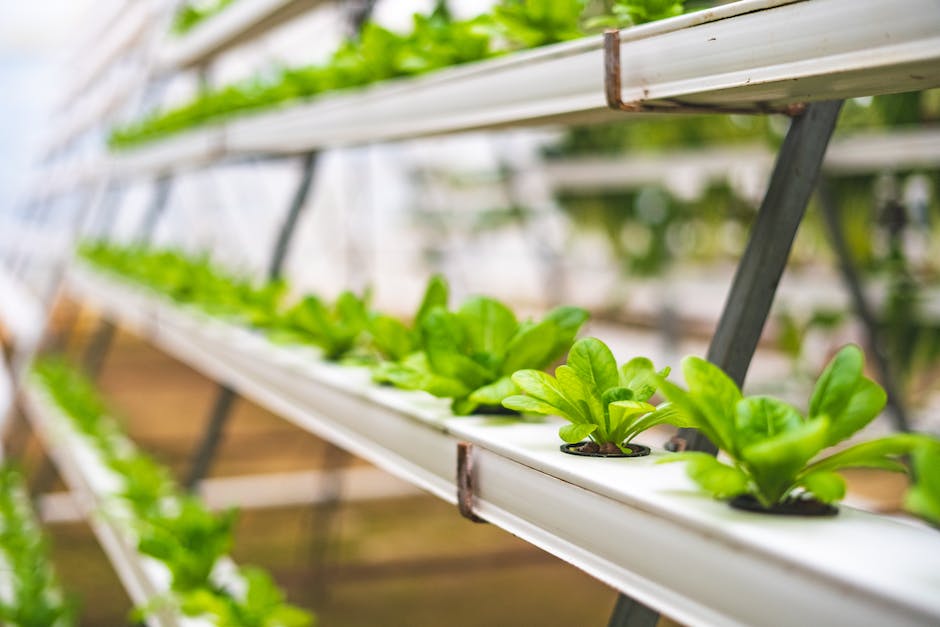Why Hydroponics Is Becoming More Popular
Hydroponics, the soilless method of gardening, is gaining immense popularity in recent years. As people become more conscious of their health and the environment, they are seeking sustainable and efficient ways to grow their own produce. Hydroponics offers an innovative solution that allows individuals to cultivate plants indoors or in limited outdoor spaces, without relying on traditional soil-based agriculture.
One of the primary reasons why hydroponics is becoming increasingly popular is its ability to conserve water. Traditional farming methods require vast amounts of water to grow crops, leading to excessive strain on freshwater resources. In contrast, hydroponics uses up to 90% less water by recirculating and reusing nutrient-rich water solutions. This water efficiency attracts eco-conscious individuals and businesses who are looking to reduce their environmental impact and lower their water bills.
Another notable advantage of hydroponics is its year-round cultivation capability. By providing plants with the essential nutrients they need directly through a water-based system, hydroponics enables plants to thrive regardless of seasonal changes. This means individuals can enjoy fresh, home-grown produce even in harsh climates or urban areas with limited access to arable land. The availability of fresh and nutritious food throughout the year is a major driving force behind the growing popularity of hydroponics.
Furthermore, with the advancement of technology, hydroponic systems have become more affordable and easier to set up. In the past, hydroponics was often associated with expensive and complex setups, limiting its accessibility to commercial farms or dedicated enthusiasts. However, with the introduction of more user-friendly systems and equipment, hydroponics is now accessible to a wider audience. From small-scale home gardening kits to larger commercial setups, individuals and businesses alike can now embark on their hydroponic journey without breaking the bank or requiring extensive horticultural knowledge.
In conclusion, hydroponics is gaining popularity due to its water efficiency, year-round cultivation capabilities, and increased accessibility. As the demand for fresh and sustainable produce continues to grow, hydroponics offers a promising solution for individuals, businesses, and communities looking to embrace a more innovative and eco-friendly approach to gardening and agriculture. Stay tuned to discover more about the benefits and applications of this innovative growing method in our upcoming blog posts.
Definition of hydroponics and its basic principles

Hydroponics is an innovative method of farming that is gaining popularity worldwide, especially in the agriculture industry. It is a soilless cultivation technique that allows plants to grow in a nutrient-rich water solution, minimizing the need for traditional soil-based growing methods.
The basic principle behind hydroponics is to provide plants with an optimized environment where they can receive all the necessary nutrients, water, and oxygen directly to their roots. This is achieved by suspending the plant roots in a water-based solution that contains a carefully balanced mixture of essential nutrients. The solution is continuously circulated around the roots, ensuring that plants receive a consistent supply of nourishment.
One of the main advantages of hydroponics is its ability to deliver nutrients directly to the plants in a highly efficient manner. By bypassing soil, plants can absorb nutrients more readily, resulting in accelerated growth rates and higher yields. This precise control over nutrient intake also reduces the risk of soil-borne diseases and pests, allowing for a healthier and more productive crop.
Furthermore, hydroponics provides greater control over environmental factors such as temperature, humidity, and lighting. This allows farmers to optimize growing conditions year-round, regardless of external climate conditions. By adjusting these parameters, farmers can tailor the environment to meet the specific needs of different plant varieties, resulting in healthier and more consistent crop growth.
Another significant advantage of hydroponics is its water-saving capabilities. Compared to traditional farming methods, hydroponics uses significantly less water as the system recirculates the nutrient solution rather than allowing it to drain away. This not only conserves water resources but also makes hydroponics a viable solution for regions facing water scarcity or limited access to clean water.
In summary, hydroponics is a soilless farming technique that offers numerous benefits over traditional agriculture. By providing plants with optimized growing conditions, including precise nutrient delivery, environmental control, and water conservation, hydroponics is revolutionizing the way we grow crops. As this innovative method gains more attention and adoption, it has the potential to play a crucial role in ensuring food security, sustainable farming practices, and efficient resource utilization in the future.
The benefits of hydroponics (such as increased efficiency and higher yields)

Hydroponics, a system of growing plants without soil, has been gaining popularity in recent years for a multitude of reasons. One of the key benefits of hydroponics is its ability to maximize efficiency and increase yields compared to traditional soil-based agriculture.
One advantage of hydroponics is the precise control it offers over the environment in which plants grow. By providing plants with the optimal temperature, pH levels, and nutrient concentrations, hydroponic systems eliminate the variability found in soil-based farming. This control allows plants to absorb nutrients more efficiently, resulting in faster and healthier growth.
Furthermore, hydroponic systems utilize water and nutrients more effectively than traditional agriculture. Unlike soil, which often retains excess water and nutrients that plants cannot access, hydroponics provide a direct and continuous supply of water and nutrients to the plants’ roots. This targeted delivery system not only reduces water usage but also minimizes the need for fertilizers, making hydroponic farming more environmentally sustainable.
In addition to increased efficiency, hydroponics also tend to yield higher crop production. With precise control over the growing conditions and the ability to maximize nutrient absorption, hydroponic plants can grow more quickly and produce larger harvests. The controlled environment also reduces the risk of diseases and pest infestations, resulting in healthier plants and higher yields.
Moreover, hydroponics allows for year-round crop production in any climate, making it especially beneficial for regions with limited arable land or extreme weather conditions. It also enables urban farming, as hydroponic systems can be set up in indoor environments such as warehouses or unused buildings. This flexibility not only enhances food security but also reduces reliance on long-distance transportation and the carbon footprint associated with it.
In conclusion, the increasing popularity of hydroponics can be attributed to its numerous benefits, including increased efficiency and higher yields. With precise control over the growing conditions, reduced water usage, and the ability to farm in any climate, this innovative agricultural method is revolutionizing the way we grow food and paving the way for a more sustainable future.
Environmental advantages (including reduced water usage and minimized pesticide usage)

Hydroponics, a soil-less method of cultivating plants, is gaining popularity not only for its impressive yields but also for its significant environmental advantages. As industries and individuals become increasingly aware of the need for sustainable and eco-friendly practices, hydroponics has emerged as a viable solution to address some of the pressing environmental concerns we face today.
One of the noteworthy advantages of hydroponics is its reduced water usage compared to traditional soil-based farming methods. With water scarcity becoming a global issue, it is crucial to find ways to conserve this precious resource. Hydroponics achieves just that by utilizing up to 90% less water compared to conventional agriculture. This is primarily because hydroponic systems are designed to recirculate and reuse water, minimizing wastage. Additionally, the plants’ roots receive water directly, eliminating the need for excessive irrigation and evaporation loss. By harnessing the power of hydroponics, we can actively contribute to conserving water resources and promoting sustainable farming practices.
Furthermore, hydroponics also allows for minimized pesticide usage, which has a positive impact on the environment. In traditional farming, pesticides are often used to protect crops from pests and diseases. However, the use of these chemicals poses risks to the environment, including soil contamination, water pollution, and harm to beneficial insects and wildlife. In hydroponics, the controlled environment and closed system reduce the need for pesticides significantly. With careful monitoring and precise nutrient delivery, pests and diseases can be effectively managed without resorting to harmful chemicals. This not only ensures a safer and healthier end product but also contributes to preserving biodiversity and protecting our fragile ecosystems.
By adopting hydroponics as a sustainable farming method, we can contribute to mitigating the negative environmental impacts associated with traditional agriculture. The reduced water usage and minimized pesticide usage make hydroponics an environmentally friendly choice. By conserving water resources and reducing chemical pollution, we can pave the way for a greener and more sustainable future. As the popularity of hydroponics continues to grow, it has the potential to revolutionize the agricultural landscape, making it more resilient, efficient, and environmentally conscious.
Exploring the growing interest in sustainable and locally sourced food

With the increasing global population and growing environmental concerns, it comes as no surprise that the interest in sustainable and locally sourced food has been on the rise. Consumers are now more conscious than ever about the origin of their food and the potential impact it has on the planet. As a result, alternative farming techniques such as hydroponics have gained significant attention and popularity.
Hydroponics, a method of growing plants without soil, offers numerous advantages that align with the growing interest in sustainable practices. First and foremost, hydroponics require significantly less water compared to traditional soil-based agriculture. The efficient use of water in hydroponic systems helps combat water scarcity issues that many regions across the globe face. This method also eliminates the need for chemical pesticides and herbicides, thereby minimizing the environmental impact associated with conventional farming.
Another key reason for the growing interest in hydroponics is its ability to produce locally sourced food, regardless of climate or geographical limitations. By reducing the reliance on fertile soil and favorable weather conditions, hydroponics allows for year-round cultivation in controlled environments such as greenhouses or indoor settings. This not only eliminates the need for long-distance transportation of food but also ensures a consistent supply of fresh produce throughout the year.
Additionally, hydroponics offers higher yields and faster growth rates compared to traditional farming methods. The ability to control key factors such as nutrient levels, pH balance, and lighting results in optimal plant growth and accelerated harvest cycles. This efficiency not only positively impacts businesses by increasing productivity but also helps meet the rising demand for food in a more time-effective manner.
The growing interest in sustainable and locally sourced food is not limited to individual consumers alone. Many restaurants, cafes, and grocery stores are also recognizing the benefits of incorporating hydroponically grown produce into their offerings. This shift not only allows businesses to promote their commitment to sustainable practices but also strengthens the local economy by supporting local farmers and reducing the carbon footprint associated with transportation.
In conclusion, as consumers become increasingly conscious of the impact of their food choices, the interest in sustainable and locally sourced food continues to grow. Hydroponics, with its water-saving techniques, year-round cultivation capabilities, higher yields, and support for local economies, has emerged as an effective solution to meet these demands. By embracing innovative farming methods like hydroponics, we can take a step towards a more sustainable and environmentally friendly future.
The rise of urban farming and the need for space-efficient growing methods

With the growing demand for fresh, locally-grown produce, urban farming has become increasingly popular in recent years. However, limited space in urban areas poses a significant challenge for traditional farming methods. This is where hydroponics, a space-efficient growing method, comes into play.
Urban farming enthusiasts are turning to hydroponics as a solution to overcome the limitations of traditional soil-based agriculture. Hydroponics is a method of growing plants without the use of soil, instead relying on nutrient-rich water solutions to provide essential minerals and elements. By eliminating the need for soil, hydroponics allows urban farmers to grow crops vertically, maximizing space utilization.
The rise of urban farming and the need for space-efficient growing methods go hand in hand. As cities become more populated and available land becomes scarce, urban farmers are embracing innovative techniques like hydroponics to meet the demand for fresh produce. Hydroponics systems can be set up in small spaces, such as balconies, rooftops, or even indoor areas like basements and unused warehouses. This flexibility makes hydroponics ideal for urban environments, as it allows farmers to utilize spaces that would otherwise remain unused.
Another advantage of hydroponics is its ability to reduce water usage compared to traditional farming methods. Hydroponic systems use recirculating water, which means that water is continuously reused instead of being lost through soil absorption. This not only conserves water but also makes hydroponics a more sustainable option in water-scarce areas, contributing to a greener urban landscape.
Hydroponics also offers precise control over growing conditions, allowing farmers to optimize plant growth and maximize crop production. With the ability to adjust factors such as nutrient levels, pH, and lighting, hydroponic systems provide an ideal environment for plants to thrive. This level of control reduces the risk of crop failure due to external factors such as droughts or pests, giving urban farmers a higher chance of success.
In conclusion, the rise of urban farming and the need for space-efficient growing methods have fueled the popularity of hydroponics. By utilizing vertical space and conserving water, hydroponics allows urban farmers to grow fresh produce in areas where traditional farming methods are not feasible. With its precise control and potential for increased crop production, hydroponics is revolutionizing urban agriculture and providing cities with a sustainable solution to meet their growing food demands.
Increased availability and affordability of hydroponic systems and supplies

In recent years, there has been a significant increase in the popularity of hydroponics as a sustainable and efficient method of growing plants. One of the key factors contributing to this trend is the increased availability and affordability of hydroponic systems and supplies.
Traditionally, hydroponic setups were considered more suitable for large-scale commercial operations due to their high cost and complexity. However, advancements in technology and a growing demand for more accessible options have led to a wider range of products becoming available to the average consumer.
Today, there are numerous manufacturers and suppliers specializing in hydroponic systems, components, and nutrient solutions. This increased competition has not only driven down the prices but has also led to improved quality and greater variety of options. As a result, individuals interested in hydroponics can now find equipment and supplies that cater to their specific needs and budget.
Additionally, the rise of e-commerce has made it easier than ever to purchase hydroponics supplies online. This convenience eliminates the need for customers to visit specialized stores or rely solely on local stockists. With just a few clicks, individuals can browse through a wide selection of hydroponic systems, grow lights, nutrients, and other essentials, comparing prices, reading customer reviews, and making informed decisions from the comfort of their own homes.
The affordability of hydroponic systems and supplies has also been influenced by increased awareness and adoption of sustainable agricultural practices. A growing number of individuals and communities are recognizing the environmental benefits of hydroponics, such as reduced water usage and elimination of harmful pesticides. As a result, there has been a push for more affordable options to encourage wider adoption of hydroponics as a socially responsible choice.
Moreover, as the popularity of hydroponics continues to rise, sustainable farming practices are being integrated into educational curriculums and workshops. This focus on education and knowledge-sharing has led to an increase in the number of affordable training programs, making hydroponics accessible to aspiring growers of all backgrounds.
In conclusion, the increased availability and affordability of hydroponic systems and supplies have played a pivotal role in driving the popularity of this innovative farming method. As more individuals are able to access and afford these resources, the barriers to entry are reduced, allowing for widespread adoption and the realization of hydroponics’ tremendous potential in revolutionizing the future of agriculture.
Success stories and examples of hydroponic farming ventures

Hydroponics, a method of growing plants without soil and using water-based nutrient solutions, is gaining popularity in the agricultural industry. This innovative technique not only provides a sustainable solution for food production but also offers numerous benefits such as higher crop yields, water conservation, and year-round cultivation. In this section, we will explore some inspiring success stories and examples of hydroponic farming ventures that have made a significant impact.
1. Gotham Greens: Starting in 2011, Gotham Greens has been revolutionizing urban farming by using hydroponics to grow fresh produce in inner-city areas. They operate high-tech greenhouse facilities on rooftops to produce pesticide-free greens, such as lettuce, herbs, and leafy greens. With an efficient system and close proximity to consumers, Gotham Greens has successfully reduced transport distances and provided local communities with access to fresh, nutritious foods.
2. Plenty: Plenty took hydroponic farming to new heights by growing crops in vertical farms. Using advanced hydroponic systems and LED lighting, Plenty can maximize crop growth density without relying on traditional farmland. Their farms produce a wide variety of leafy greens, vegetables, and fruits, enabling them to supply local grocery stores and restaurants year-round. Plenty’s sustainable approach has garnered attention for its potential to revolutionize food production in densely populated urban areas.
3. AeroFarms: Based in New Jersey, AeroFarms has developed one of the largest indoor vertical farms in the world. Their state-of-the-art facility utilizes aeroponic systems, a variation of hydroponics that mist the plant roots with a nutrient-rich solution. By controlling environmental factors like lighting, temperature, and humidity, AeroFarms ensures optimal crop growth and consistent quality. Through their innovative hydroponic practices, AeroFarms demonstrates the potential for sustainable agriculture to meet the growing demand for fresh produce.
4. Freight Farms: Focusing on bringing hydroponics to urban environments, Freight Farms repurposes shipping containers into self-contained hydroponic farming systems. These “farms inside boxes” offer flexibility and mobility, allowing farmers to grow a wide range of crops in various locations. Freight Farms’ hydroponic containers have been used for community-supported agriculture programs, schools, and even remote locations where traditional farming is challenging. Their approach demonstrates that hydroponics can adapt to different settings and provide local food solutions.
These success stories and examples highlight the growing influence of hydroponics in sustainable farming practices. By utilizing innovative technologies and adopting efficient methods, these ventures provide fresh, locally grown produce while minimizing environmental impacts. As hydroponics continues to evolve, it offers an exciting potential for increasing food production in a world where traditional agriculture faces numerous challenges.
Hydroponics as a solution for food security and global challenges

Hydroponics as a Solution for Food Security and Global Challenges
In recent years, hydroponics has gained significant attention as an innovative solution to address the growing concern of food security and global challenges. With a rapidly increasing global population, unpredictable weather patterns, and limited arable land available for traditional agriculture, the need for sustainable and efficient farming methods has become more critical than ever.
One of the primary advantages of hydroponics is its ability to produce food in any location, regardless of climate or geographic limitations. By cultivating plants in a controlled indoor environment, hydroponics eliminates the reliance on fertile soil, making it possible to grow crops in regions where traditional farming methods would not be feasible. This has the potential to revolutionize food production, particularly in areas with limited access to arable land or where the climate is unsuitable for conventional agriculture.
Additionally, hydroponics offers a more sustainable approach to farming by minimizing water usage and reducing the need for harmful pesticides or herbicides. The closed-loop system used in hydroponics allows for the precise delivery of water, nutrients, and oxygen directly to the plant roots, resulting in optimal growth and higher yields. Compared to traditional soil-based farming, hydroponics can use up to 90% less water, making it a more resource-efficient and environmentally friendly method of agriculture.
Furthermore, hydroponics has the potential to significantly increase the availability of fresh produce throughout the year. By providing a controlled environment for plant growth, hydroponics allows for year-round cultivation, regardless of seasonal limitations. This not only reduces the dependence on seasonal imports but also helps to combat food scarcity and price fluctuations that occur due to limited supply during certain times of the year.
Another key advantage of hydroponics is its potential to reduce the carbon footprint associated with food production. By eliminating the need for long-distance transportation and minimizing the use of fossil fuels in traditional farming practices, hydroponics has the capacity to localize food production and decrease greenhouse gas emissions. This localized approach to farming also supports local economies, creating employment opportunities and fostering community engagement.
In conclusion, hydroponics is emerging as a promising solution for addressing global challenges related to food security and sustainable agriculture. With its ability to overcome geographical limitations, maximize resource efficiency, increase year-round crop production, and reduce carbon emissions, hydroponics offers a viable alternative to traditional farming methods. As more businesses and individuals recognize the potential of hydroponics, this innovative approach to agriculture could play a significant role in ensuring a secure and sustainable food supply for future generations.

